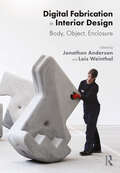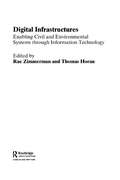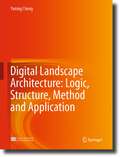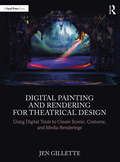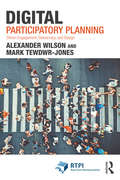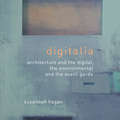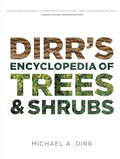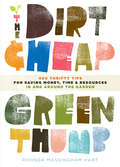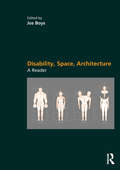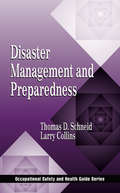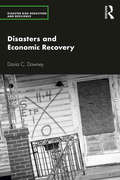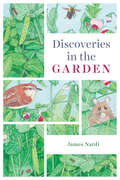- Table View
- List View
Digital Fabrication in Interior Design: Body, Object, Enclosure
by Jonathon Anderson Lois WeinthalDigital Fabrication in Interior Design: Body, Object, Enclosure draws together emerging topics of making that span primary forms of craftsmanship to digital fabrication in order to theoretically and practically analyze the innovative and interdisciplinary relationship between digital fabrication technology and interior design. The history of making in interior design is aligned with traditional crafts, but a parallel discourse with digital fabrication has yet to be made evident. This book repositions the praxis of experimental prototyping and integrated technology to show how the use of digital fabrication is inherent to the interior scales of body, objects and enclosure. These three scales act as a central theme to frame contributions that reinforce the interdisciplinary nature of interior design and reinterpret traditional crafts by integrating new methods of making into conventional workflows. Featuring significant international practitioners and researchers, the selected contributions represent the ever-increasing interdisciplinary nature of design, demonstrating a breadth of disciplines. A foundational text for interiors students and practitioners, Digital Fabrication in Interior Design expands the necessary dialogue about digital fabrication at the scale of interiors to inform design theory and practice.
Digital Fabrication in Interior Design: Body, Object, Enclosure
by Jonathon Anderson Lois WeinthalDigital Fabrication in Interior Design: Body, Object, Enclosure draws together emerging topics of making that span primary forms of craftsmanship to digital fabrication in order to theoretically and practically analyze the innovative and interdisciplinary relationship between digital fabrication technology and interior design. The history of making in interior design is aligned with traditional crafts, but a parallel discourse with digital fabrication has yet to be made evident. This book repositions the praxis of experimental prototyping and integrated technology to show how the use of digital fabrication is inherent to the interior scales of body, objects and enclosure. These three scales act as a central theme to frame contributions that reinforce the interdisciplinary nature of interior design and reinterpret traditional crafts by integrating new methods of making into conventional workflows. Featuring significant international practitioners and researchers, the selected contributions represent the ever-increasing interdisciplinary nature of design, demonstrating a breadth of disciplines. A foundational text for interiors students and practitioners, Digital Fabrication in Interior Design expands the necessary dialogue about digital fabrication at the scale of interiors to inform design theory and practice.
Digital Infrastructures: Enabling Civil and Environmental Systems through Information Technology (Networked Cities Series)
by Thomas Horan Rae ZimmermanAn invisible network of digital technology systems underlies the highly visible networks of roads, waterways, satellites, and power-lines. Increasingly, these systems are becoming the "infrastructure's infrastructure," providing a crucial array of data on network demand, performance, reliability, and security. Digital Infrastructures presents an interdisciplinary analysis of the technological systems that envelop these networks. The book balances analyses of specific civil and environmental infrastructures with broader policy and management issues, including the challenges of using IT to manage these critical systems under crises conditions.
Digital Infrastructures: Enabling Civil and Environmental Systems through Information Technology (Networked Cities Series)
by Rae Zimmerman Thomas HoranAn invisible network of digital technology systems underlies the highly visible networks of roads, waterways, satellites, and power-lines. Increasingly, these systems are becoming the "infrastructure's infrastructure," providing a crucial array of data on network demand, performance, reliability, and security. Digital Infrastructures presents an interdisciplinary analysis of the technological systems that envelop these networks. The book balances analyses of specific civil and environmental infrastructures with broader policy and management issues, including the challenges of using IT to manage these critical systems under crises conditions.
Digital Landscape Architecture: Logic, Structure, Method and Application
by Yuning ChengClosely related to the frontier research field of “digital technology”, this book reshapes the planning and design process of landscape architecture from theoretical and practical levels. It gives a full-scale discussion to the logic, structure, method, and application of digital landscape architecture, leading this field to a new era of perception-quantification research mode. Readers will get a comprehensive understanding of digital landscape architecture, know about multiple digital methods for landscape planning and design, and learn a lot of practical projects with digital technology. And it will inspire the readers to think about new patterns and approaches to landscape planning, rather than traditional ways. This book is organized under a clear logic, which helps the readers easily get the core of the work. A lot of logic diagrams showing between the theoretical paragraphs highly summarize the key points of the book, providing a better readability and acceptability. This book also contains many detailed drawings and graphics for the project cases, which gives a good demonstration of how digital methods could be applied in practice.
Digital Painting and Rendering for Theatrical Design: Using Digital Tools to Create Scenic, Costume, and Media Renderings
by Jen GilletteDigital Painting and Rendering for Theatrical Design explores the tools and techniques for creating dazzling, atmospheric, and evocative digitally painted renderings for scenic, costume, and projection/integrated media design. By focusing on technique rather than the structure of a particular software, this book trains theatrical designers to think and paint digitally, regardless of the software or hardware they choose. The text begins with the construction of the artist’s physical and digital workspace, then delves into an explanation of tool functionality, technique-building exercises, and examples from professional theatrical designers to help contextualize the concepts presented. Each chapter gradually progresses in complexity through skill-building exercises and advanced tool functionality, covering concepts like brush construction, various forms of masking, and layer interaction. The book explores various methods of constructing a digital rendering, including producing digital paintings that look like traditional media and photo bashing – the practice of using extant photographs to create a collaged image. Concepts are contextualized throughout the text using illustrations, quotes, and interviews with working professional designers. This beautifully illustrated guide is written for professional theatrical artists, students of theatrical design, and other visual artists looking to broaden their digital painting skillset.
Digital Painting and Rendering for Theatrical Design: Using Digital Tools to Create Scenic, Costume, and Media Renderings
by Jen GilletteDigital Painting and Rendering for Theatrical Design explores the tools and techniques for creating dazzling, atmospheric, and evocative digitally painted renderings for scenic, costume, and projection/integrated media design. By focusing on technique rather than the structure of a particular software, this book trains theatrical designers to think and paint digitally, regardless of the software or hardware they choose. The text begins with the construction of the artist’s physical and digital workspace, then delves into an explanation of tool functionality, technique-building exercises, and examples from professional theatrical designers to help contextualize the concepts presented. Each chapter gradually progresses in complexity through skill-building exercises and advanced tool functionality, covering concepts like brush construction, various forms of masking, and layer interaction. The book explores various methods of constructing a digital rendering, including producing digital paintings that look like traditional media and photo bashing – the practice of using extant photographs to create a collaged image. Concepts are contextualized throughout the text using illustrations, quotes, and interviews with working professional designers. This beautifully illustrated guide is written for professional theatrical artists, students of theatrical design, and other visual artists looking to broaden their digital painting skillset.
Digital Participatory Planning: Citizen Engagement, Democracy, and Design (RTPI Library Series)
by Alexander Wilson Mark Tewdwr-JonesDigital Participatory Planning outlines developments in the field of digital planning and designs and trials a range of technologies, from the use of apps and digital gaming through to social media, to examine how accessible and effective these new methods are. It critically discusses urban planning, democracy, and computing technology literature, and sets out case studies on design and deployment. It assesses whether digital technology offers an opportunity for the public to engage with urban change, to enhance public understanding and the quality of citizen participation, and to improve the proactive possibilities of urban planning more generally. The authors present an exciting alternative story of citizen engagement in urban planning through the reimagination of participation that will be of interest to students, researchers, and professionals engaged with a digital future for people and planning.
Digital Participatory Planning: Citizen Engagement, Democracy, and Design (RTPI Library Series)
by Alexander Wilson Mark Tewdwr-JonesDigital Participatory Planning outlines developments in the field of digital planning and designs and trials a range of technologies, from the use of apps and digital gaming through to social media, to examine how accessible and effective these new methods are. It critically discusses urban planning, democracy, and computing technology literature, and sets out case studies on design and deployment. It assesses whether digital technology offers an opportunity for the public to engage with urban change, to enhance public understanding and the quality of citizen participation, and to improve the proactive possibilities of urban planning more generally. The authors present an exciting alternative story of citizen engagement in urban planning through the reimagination of participation that will be of interest to students, researchers, and professionals engaged with a digital future for people and planning.
Digital Transformations for Lighting in the Workplace: A Systematic Approach Used in Ergonomics
by Darina Dupláková Ján DuplákDigital Transformations for Lighting in the Workplace: A Systematic Approach Used in Ergonomics offers a practical concept for the implementation of digital transformation in ergonomics in work settings. It specifically focuses on providing information about illumination in production and non-production fields, and the described design solutions are applicable in practice. The concepts can be used in a typical manufacturing workplace or an academic setting. The methods in the book complement the modern trend to digitalise the workplace, making the research and practical outcomes of this book compatible with the concept of Industry 4.0 - Digital Manufacturing. This title offers a systematic approach to the field of digital transformation for ergonomics. It presents an opportunity for the reader to learn to create a digital model for lighting by analysing mathematical models for calculation through formulas and simulation algorithms. To put learning into context, this book provides two case studies from the production and non-production sectors, including an example of a classroom. The reader will then be able to utilise the methods to create their own digitized illumination system. This monograph is an ideal read for academics and researchers working at universities in the field of Ergonomics and professionals in industrial management including those in manufacturing plants, ergonomists, designers from the industry sector, or people who are interested in ergonomics, digitization, and simulation of a working environment.
Digital Transformations for Lighting in the Workplace: A Systematic Approach Used in Ergonomics
by Darina Dupláková Ján DuplákDigital Transformations for Lighting in the Workplace: A Systematic Approach Used in Ergonomics offers a practical concept for the implementation of digital transformation in ergonomics in work settings. It specifically focuses on providing information about illumination in production and non-production fields, and the described design solutions are applicable in practice. The concepts can be used in a typical manufacturing workplace or an academic setting. The methods in the book complement the modern trend to digitalise the workplace, making the research and practical outcomes of this book compatible with the concept of Industry 4.0 - Digital Manufacturing. This title offers a systematic approach to the field of digital transformation for ergonomics. It presents an opportunity for the reader to learn to create a digital model for lighting by analysing mathematical models for calculation through formulas and simulation algorithms. To put learning into context, this book provides two case studies from the production and non-production sectors, including an example of a classroom. The reader will then be able to utilise the methods to create their own digitized illumination system. This monograph is an ideal read for academics and researchers working at universities in the field of Ergonomics and professionals in industrial management including those in manufacturing plants, ergonomists, designers from the industry sector, or people who are interested in ergonomics, digitization, and simulation of a working environment.
Digitalia: Architecture and the Digital, the Environmental and the Avant-Garde
by Susannah HaganSusannah Hagan boldly discusses the fraught relationship between key dominating areas of architectural discourse - digital design, environmental design, and avant-garde design.Digitalia firstly demonstrates that drawing such firm lines between architectural spheres is damaging and foolish, particularly as both environmental and avant-garde practices are experimenting with the digital, and secondly remonstrates with an avant-garde that has repudiated the social/ethical agenda of the modernist avant-garde because it failed the first time round. It is environmental architecture that has picked up the social/ethical ball and is running with it, using the digital to very different, and more far-reaching, ends.As the debates rage, this book is a key read for all who are involved or intrigued.
Digitalia: Architecture and the Digital, the Environmental and the Avant-Garde
by Susannah HaganSusannah Hagan boldly discusses the fraught relationship between key dominating areas of architectural discourse - digital design, environmental design, and avant-garde design.Digitalia firstly demonstrates that drawing such firm lines between architectural spheres is damaging and foolish, particularly as both environmental and avant-garde practices are experimenting with the digital, and secondly remonstrates with an avant-garde that has repudiated the social/ethical agenda of the modernist avant-garde because it failed the first time round. It is environmental architecture that has picked up the social/ethical ball and is running with it, using the digital to very different, and more far-reaching, ends.As the debates rage, this book is a key read for all who are involved or intrigued.
Dirr's Encyclopedia of Trees and Shrubs
by Michael A. DirrA combination of Dirr's bestselling books under one cover, adding new plants, new photographs, plus all new commentary in Dirr's signature style, Dirr's Encyclopedia of Trees and Shrubs is the bible of woody plants.
The Dirt-Cheap Green Thumb: 400 Thrifty Tips for Saving Money, Time, and Resources as You Garden
by Rhonda Massingham HartDiscover how frugal gardening can lead to fantastic results! Rhonda Massingham Hart provides practical, time-tested tips that stretch your dollar even as they yield beautiful, bountiful plants. From starting seeds to preserving produce, Hart&’s advice ensures that you won&’t waste time and money while growing your own vegetables, flowers, houseplants, or landscape foliage. Perfect for thrifty gardeners of all levels, The Dirt-Cheap Green Thumb covers everything you want to grow, indoors and out.
Disability, Space, Architecture: A Reader
by Jos BoysDisability, Space, Architecture: A Reader takes a groundbreaking approach to exploring the interconnections between disability, architecture and cities. The contributions come from architecture, geography, anthropology, health studies, English language and literature, rhetoric and composition, art history, disability studies and disability arts and cover personal, theoretical and innovative ideas and work. Richer approaches to disability – beyond regulation and design guidance – remain fragmented and difficult to find for architectural and built environment students, educators and professionals. By bringing together in one place some seminal texts and projects, as well as newly commissioned writings, readers can engage with disability in unexpected and exciting ways that can vibrantly inform their understandings of architecture and urban design. Most crucially, Disability, Space, Architecture: A Reader opens up not just disability but also ability – dis/ability – as a means of refusing the normalisation of only particular kinds of bodies in the design of built space. It reveals how our everyday social attitudes and practices about people, objects and spaces can be better understood through the lens of disability, and it suggests how thinking differently about dis/ability can enable innovative and new kinds of critical and creative architectural and urban design education and practice.
Disability, Space, Architecture: A Reader
by Jos BoysDisability, Space, Architecture: A Reader takes a groundbreaking approach to exploring the interconnections between disability, architecture and cities. The contributions come from architecture, geography, anthropology, health studies, English language and literature, rhetoric and composition, art history, disability studies and disability arts and cover personal, theoretical and innovative ideas and work. Richer approaches to disability – beyond regulation and design guidance – remain fragmented and difficult to find for architectural and built environment students, educators and professionals. By bringing together in one place some seminal texts and projects, as well as newly commissioned writings, readers can engage with disability in unexpected and exciting ways that can vibrantly inform their understandings of architecture and urban design. Most crucially, Disability, Space, Architecture: A Reader opens up not just disability but also ability – dis/ability – as a means of refusing the normalisation of only particular kinds of bodies in the design of built space. It reveals how our everyday social attitudes and practices about people, objects and spaces can be better understood through the lens of disability, and it suggests how thinking differently about dis/ability can enable innovative and new kinds of critical and creative architectural and urban design education and practice.
Disaster Management and Preparedness
by Larry R. CollinsDetailing methods for preparing organizations for disasters, this book discusses not only tried and true tactics, but also areas often overlooked during the reactive and post-disaster phases. The authors address special considerations important in planning for disaster management, from chemical spills, floods, aircraft crashes, and terrorist attack
Disasters and Economic Recovery (Disaster Risk Reduction and Resilience)
by Davia C. DowneyDisasters and Economic Recovery provides perspectives on the economic issues that emerge before, during, and after natural disasters in an international context, by assessing the economic development patterns that emerge before and after disaster. This book will provide a historical overview of emergency management policy and previous responses to disasters in each country, as well as the policy learning that occurred in each case leading up to the disasters under analysis. The book highlights four cases: New Orleans; Christchurch, New Zealand; the Japan earthquake and tsunami; and Hurricane Sandy in the Northeastern United States. The book places important focus on the specific collaborative developments unique to the rebuilding of each place’s economy post-disaster. Using time-series data, the book shows the emergence of new industries and job hiring patterns in the immediate aftermath, as well as provides a picture of the economic performance of each country in the years following each event. Looking at the economic development policies pre- and post-disaster, readers will glean important lessons on how to build resilient economies within the disaster framework, highlighting the differences in approaches to rebuilding local economies in places with varying levels of governmental capacity post-disaster to inform policymakers, scholars, and the disaster relief community as they plan their response to future disasters.
Disasters and Economic Recovery (Disaster Risk Reduction and Resilience)
by Davia C. DowneyDisasters and Economic Recovery provides perspectives on the economic issues that emerge before, during, and after natural disasters in an international context, by assessing the economic development patterns that emerge before and after disaster. This book will provide a historical overview of emergency management policy and previous responses to disasters in each country, as well as the policy learning that occurred in each case leading up to the disasters under analysis. The book highlights four cases: New Orleans; Christchurch, New Zealand; the Japan earthquake and tsunami; and Hurricane Sandy in the Northeastern United States. The book places important focus on the specific collaborative developments unique to the rebuilding of each place’s economy post-disaster. Using time-series data, the book shows the emergence of new industries and job hiring patterns in the immediate aftermath, as well as provides a picture of the economic performance of each country in the years following each event. Looking at the economic development policies pre- and post-disaster, readers will glean important lessons on how to build resilient economies within the disaster framework, highlighting the differences in approaches to rebuilding local economies in places with varying levels of governmental capacity post-disaster to inform policymakers, scholars, and the disaster relief community as they plan their response to future disasters.
Discoveries in the Garden
by James B. NardiEvery square inch of soil is rich with energy and life, and nowhere is this more evident than in the garden. At the tips of our trowels, a sun-driven world of microbes, insects, roots, and stems awaits—and it is a world no one knows better than James Nardi. A charming guide to all things green and growing, Nardi is as at home in prairies, forests, and wetlands as he is in the vegetable patch. And with Discoveries in the Garden, he shows us that these spaces aren’t as different as we might think, that nature flourishes in our backyards, schoolyards, and even indoors. To find it, we’ve only got to get down into the dirt. Leading us through the garden gate, Nardi reveals the extraordinary daily lives and life cycles of a quick-growing, widely available, and very accommodating group of study subjects: garden plants. Through close observations and simple experiments we all can replicate at home, we learn the hidden stories behind how these plants grow, flower, set seeds, and produce fruits, as well as the vital role dead and decomposing plants play in nourishing the soil. From pollinators to parasites, plant calisthenics to the wisdom of weeds, Nardi’s tale also introduces us to our fellow animal and microbial gardeners, the community of creatures both macro- and microscopic with whom we share our raised beds. Featuring a copse of original, informative illustrations that are as lush as the garden plants themselves, Discoveries in the Garden is an enlightening romp through the natural history, science, beauty, and wonder of these essential green places.
Discoveries in the Garden
by James B. NardiEvery square inch of soil is rich with energy and life, and nowhere is this more evident than in the garden. At the tips of our trowels, a sun-driven world of microbes, insects, roots, and stems awaits—and it is a world no one knows better than James Nardi. A charming guide to all things green and growing, Nardi is as at home in prairies, forests, and wetlands as he is in the vegetable patch. And with Discoveries in the Garden, he shows us that these spaces aren’t as different as we might think, that nature flourishes in our backyards, schoolyards, and even indoors. To find it, we’ve only got to get down into the dirt. Leading us through the garden gate, Nardi reveals the extraordinary daily lives and life cycles of a quick-growing, widely available, and very accommodating group of study subjects: garden plants. Through close observations and simple experiments we all can replicate at home, we learn the hidden stories behind how these plants grow, flower, set seeds, and produce fruits, as well as the vital role dead and decomposing plants play in nourishing the soil. From pollinators to parasites, plant calisthenics to the wisdom of weeds, Nardi’s tale also introduces us to our fellow animal and microbial gardeners, the community of creatures both macro- and microscopic with whom we share our raised beds. Featuring a copse of original, informative illustrations that are as lush as the garden plants themselves, Discoveries in the Garden is an enlightening romp through the natural history, science, beauty, and wonder of these essential green places.
Discoveries in the Garden
by James B. NardiEvery square inch of soil is rich with energy and life, and nowhere is this more evident than in the garden. At the tips of our trowels, a sun-driven world of microbes, insects, roots, and stems awaits—and it is a world no one knows better than James Nardi. A charming guide to all things green and growing, Nardi is as at home in prairies, forests, and wetlands as he is in the vegetable patch. And with Discoveries in the Garden, he shows us that these spaces aren’t as different as we might think, that nature flourishes in our backyards, schoolyards, and even indoors. To find it, we’ve only got to get down into the dirt. Leading us through the garden gate, Nardi reveals the extraordinary daily lives and life cycles of a quick-growing, widely available, and very accommodating group of study subjects: garden plants. Through close observations and simple experiments we all can replicate at home, we learn the hidden stories behind how these plants grow, flower, set seeds, and produce fruits, as well as the vital role dead and decomposing plants play in nourishing the soil. From pollinators to parasites, plant calisthenics to the wisdom of weeds, Nardi’s tale also introduces us to our fellow animal and microbial gardeners, the community of creatures both macro- and microscopic with whom we share our raised beds. Featuring a copse of original, informative illustrations that are as lush as the garden plants themselves, Discoveries in the Garden is an enlightening romp through the natural history, science, beauty, and wonder of these essential green places.
Discoveries in the Garden
by James B. NardiEvery square inch of soil is rich with energy and life, and nowhere is this more evident than in the garden. At the tips of our trowels, a sun-driven world of microbes, insects, roots, and stems awaits—and it is a world no one knows better than James Nardi. A charming guide to all things green and growing, Nardi is as at home in prairies, forests, and wetlands as he is in the vegetable patch. And with Discoveries in the Garden, he shows us that these spaces aren’t as different as we might think, that nature flourishes in our backyards, schoolyards, and even indoors. To find it, we’ve only got to get down into the dirt. Leading us through the garden gate, Nardi reveals the extraordinary daily lives and life cycles of a quick-growing, widely available, and very accommodating group of study subjects: garden plants. Through close observations and simple experiments we all can replicate at home, we learn the hidden stories behind how these plants grow, flower, set seeds, and produce fruits, as well as the vital role dead and decomposing plants play in nourishing the soil. From pollinators to parasites, plant calisthenics to the wisdom of weeds, Nardi’s tale also introduces us to our fellow animal and microbial gardeners, the community of creatures both macro- and microscopic with whom we share our raised beds. Featuring a copse of original, informative illustrations that are as lush as the garden plants themselves, Discoveries in the Garden is an enlightening romp through the natural history, science, beauty, and wonder of these essential green places.
Discoveries in the Garden
by James B. NardiEvery square inch of soil is rich with energy and life, and nowhere is this more evident than in the garden. At the tips of our trowels, a sun-driven world of microbes, insects, roots, and stems awaits—and it is a world no one knows better than James Nardi. A charming guide to all things green and growing, Nardi is as at home in prairies, forests, and wetlands as he is in the vegetable patch. And with Discoveries in the Garden, he shows us that these spaces aren’t as different as we might think, that nature flourishes in our backyards, schoolyards, and even indoors. To find it, we’ve only got to get down into the dirt. Leading us through the garden gate, Nardi reveals the extraordinary daily lives and life cycles of a quick-growing, widely available, and very accommodating group of study subjects: garden plants. Through close observations and simple experiments we all can replicate at home, we learn the hidden stories behind how these plants grow, flower, set seeds, and produce fruits, as well as the vital role dead and decomposing plants play in nourishing the soil. From pollinators to parasites, plant calisthenics to the wisdom of weeds, Nardi’s tale also introduces us to our fellow animal and microbial gardeners, the community of creatures both macro- and microscopic with whom we share our raised beds. Featuring a copse of original, informative illustrations that are as lush as the garden plants themselves, Discoveries in the Garden is an enlightening romp through the natural history, science, beauty, and wonder of these essential green places.
